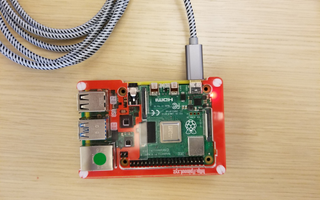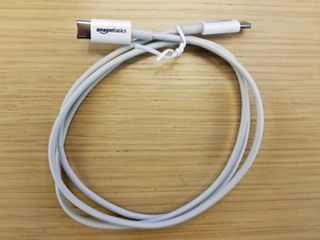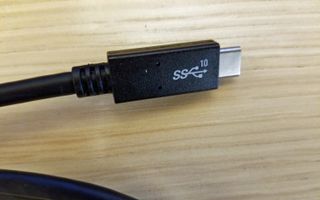Tested: 10+ Raspberry Pi 4 USB-C Cables That Work
All these USB-C cables will charge the Raspberry Pi 4.

The Raspberry Pi 4 B’s USB Type-C port offers a big improvement over the microUSB ports on prior Raspberry Pi models, because USB-C is reversible and it’s both the present and future of connectivity. Unfortunately the first set of Pi 4s to hit store shelves have a hardware bug that stops them from working with some USB-C cables. But how serious of a problem is it? According to our tests: not very.
We bought 10 popular USB Type-C to Type-C cables from Amazon, grabbed a few additional cables we had lying around the office and tried using each of them to boot up our Raspberry Pi 4 B. In total, we tried out 14 different cables and found that 11 of them powered on the Pi without issue.
| Name | Works? | Buy | Notes |
| AmazonBasics USB Type-C 2.0 (3 feet) | Yes | Amazon Basics USB-C 2.0 Cable | Row 1 - Cell 3 |
| Anker Powerline USB-C to USB-C 2.0 Cable (3 feet) | Yes | Anker Powerline USB-C to USB-C 2.0 Cable | Row 2 - Cell 3 |
| Anker PowerLine+ C to C 2.0 cable (6 feet) | Yes | Anker PowerLine+ C to C 2.0 Cable | Row 3 - Cell 3 |
| Apple USB-C Cable (3.3 feet) | No | Apple USB-C Connector | Comes with MacBooks and sold seperately |
| Aukey USB C to USB C, USB 2.0, (3 feet) | Yes | Aukey USB C to USB C, USB 2.0, 3-foot | Row 5 - Cell 3 |
| BrexLink Type-C to Type-C Cable, (6.6 feet) | Yes | Brexlink Type-C to Type-C cable (6.6 feet), 2 Pack | Comes in two-pack |
| Cable Matters USB 2.0 Type-C Cable (1 foot) | Yes | Cable Matters USB-C to USB-C Cable (1 foot) | Comes in two-pack |
| CableCreation USB Type-C (10 feet) | Yes | CableCreation USB Type-C Cable (10 feet) | Row 8 - Cell 3 |
| Inateck Type-C Cable (6.6 feet) | Yes | Inateck 45W Universal USB C Power Adapter | Only available with 45-watt charger. |
| JSAUX USB-C to USB-C Cable 3A (6.6 feet) | Yes | JSAUX USB-C to USB-C Cable (6.6 feet), 2 Pack | Comes in two-pack. |
| Lenovo ThinkPad USB-C Charger | Yes | Lenovo 65w USB Type C AC Adapter | 65-watt charger |
| Monoprice 3.1 USB-C to USB-C Gen 2 Cable (3.3 feet) | No | Monoprice 3.1 USB-C to USB-C Gen 2 Cable (3.3 feet) | Supports 10 Gbps speeds |
| Plugable 10 Gbps USB-C to USB-C Cable, | No | Plugable 10 Gbps USB-C to USB-C Cable (3.3 feet) | Supports 10 Gbps |
| Vinpok Bolt USB-C Magnetic Charging Cable | Yes | Vinpok Bolt USB-C Magenetic Charging Cable | Magnetic , detachable head, 87 watts |
The table above shows a breakdown of these cables, along with links to buy the ones that work. As you can see, most of the working Type-C cables are all under $10 and, in many cases, under $7. A couple of the cables in our office worked, but you can’t buy them by themselves. The Inatek cable must be purchased with an Inatek charger that delivers a full 45 watts of power and the 65-watt Lenovo ThinkPad charger has its cable built-in, but we tested it to show that, if you have one for your laptop, you can use it for a Pi.
Of course, you’ll still need an AC adapter that delivers 5 volts and at least 3 amps of power so, unless you already have one, your best bet might be to buy the official Raspberry Pi 4 power supply, which comes with a built-in cable and goes for $8 to $10, but isn’t yet listed on Amazon. During testing, we used a 30-watt Anker PowerPort Speed+ charger that worked well, but is more powerful than we needed.

Electronically Marked Cables to Blame
The reason why some USB Type-C cables won’t power the Raspberry Pi 4 is that the Pi’s USB Type-C port doesn’t have the correct number of resistors (see resistor color codes) to identify itself to higher-end, “electronically marked” cables. These cables, which usually support higher speed transfers, require two dedicated pull down resistors connected for the port, because they use two lines to communicate with devices. Pi Founder Eben Upton told us that future revisions to the Pi 4 B will have the necessary resistor, but current boards can’t be fixed via firmware.
A chip inside the e-marked cables controls whether or not they will deliver power and, not seeing the second resistor, it assumes that the Pi 4 is a USB audio device and delivers no juice. If you connect an e-marked cables to your Pi 4, the board won’t even light up.
Most product descriptions for USB type-C cables don’t mention whether they are electronically marked, but there are several indicators. USB Type-C to Type-A cables aren’t electronically marked and USB Type-C cables that only operate at USB 2.0 speeds or only charge shouldn’t have the chip in them either.
Stay on the Cutting Edge
Join the experts who read Tom's Hardware for the inside track on enthusiast PC tech news — and have for over 25 years. We'll send breaking news and in-depth reviews of CPUs, GPUs, AI, maker hardware and more straight to your inbox.
How to Find a Working Cable
It’s Type-C to Type-C cables that support USB 3.1 / 3.2, operating at 5 or 10 Gbps and Thunderbolt cables that are most likely to be e-marked. In our tests, every single cable that was listed as USB 2.0 (aka 480 Mbps) worked and those that were USB 3.x (aka 5 Gbps or 10 Gbps) failed. Apple’s USB-C cable, which came with our office MacBook, also failed when it is listed as a charging cable only also failed.

Unfair Criticism?
The Raspberry Pi Foundation took a lot of nasty criticism from the press for a problem that’s not going to affect a lot of people in real life. The Verge said “the Raspberry Pi Foundation messed up its first USB-C device” and our colleagues at PC Gamer said that the organization “admits it screwed up the USB-C port.” Those are some harsh words for a very minor problem.
Yes, it would be nice to, in a pinch, grab the same USB-C cable that you use came with your $1,300 MacBook and plug it into your $35 Raspberry Pi 4 B, but chances are that you’ll save it for the laptop. And many other laptop chargers, including a ThinkPad charger, will work. And it would be ideal if you could take the same USB 3.2 or Thunderbolt cable that you use to connect to an external SSD, a monitor or a docking station for your Pi, but how often are you going to take a high-speed, expensive cable and use it for this purpose?

You might argue that USB is supposed to “just work,” but Type-C cables and ports have had a lot of confusing incompatibilities long before the Pi 4 came out. If you just grab a random cable with Type-C connectors on both ends, you could end up with a data connection that supports speeds of 480 Mbps, 5 Gbps, 10 Gbps or even 40 Gbps and some cables are for charging only and don’t do data.
You also can’t tell just from looking at a USB port on a computer what speeds it supports whether it will let you use it to charge your device and whether it supports alternate mode for outputting video. Also, some laptops, including several HP models, will only charge with USB-C AC adapters from the company that made them.
So, in reality, the USB Type-C problem on Raspberry Pi 4 occurs only in an unlikely scenario. Most USB Type-C cables will power the Pi, and those that don’t are ones you wouldn’t use for this purpose.
MORE: Raspberry Pi GPIO Pinout: What Each Pin Does
MORE: How to Use Raspberry Pi as a VPN Gateway
MORE: Raspberry Pi Tutorials
Most Popular







